A Blast from the Past: Wood Floors in the 1920’s
In our last article I featured a couple of old hardwood floor brochures from the late 1800’s. For this post I want to show you another couple of brochures that I found from the 1920’s. It can be fun to look through these and see what they did back then, where our industry has come from and to see all the advancements made throughout the years.
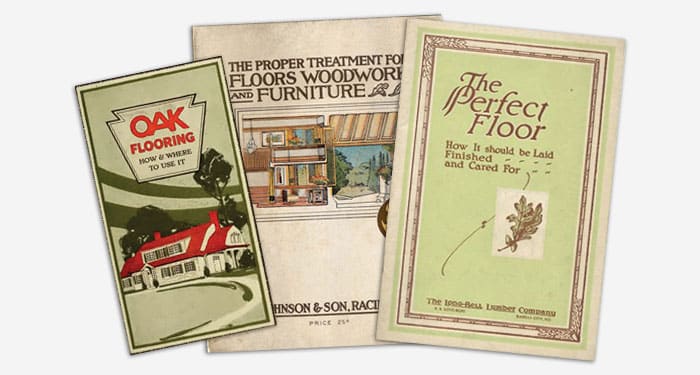
The 1920’s were a time of economic boom after World War 1 had ended. They were called the roaring 20’s for a reason. Music, fashion, lifestyles, (hairstyles) and culture were all going through major changes. Jazz, automobiles, telephones and motion pictures from Hollywood were all the rage.
It was also a big transition period for housing and architecture.
There were a lot of changes and improved standards in residential home building. New materials and building methods meant houses were easier to heat and cool, were more hygienic, and far better suited to modern living.
Oak hardwood flooring really came into its own during this period.
New manufacturing processes meant better milled and more stable flooring was available (you can see an illustration of new milling techniques a few pictures below). Cool patterns like herringbone, chevron and basket weave were popular with wealthier homeowners… as well as parquet and strip flooring for ‘average’ homes.
That’s when this brochure came onto the scene. For those with good eyes you can see it’s also from right here in Chicago in 1920…

Below you can see the different types and grades of oak flooring offered back then and the suggestions of which type of application they would be suited to…
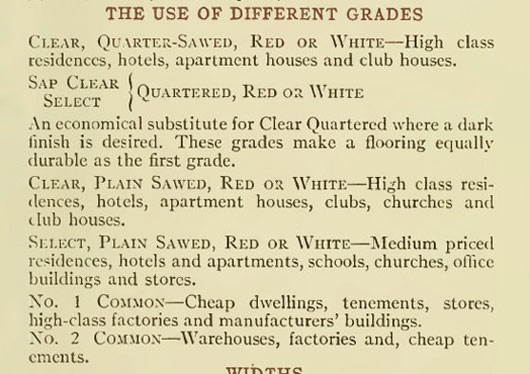
For those that didn’t have money floating around like many of the high flyers in the 20’s, there are suggestions on how to have the ‘look’ of high-end flooring for substantial savings – up to 40% in savings!
Apparently this was quite a common practice in those days as you can read in a section of the brochure below…

So that explains why your 1920-30’s home in the Chicagoland area may have two different grades of wood in the same room. Interesting hey.
Below you can see the changes in milling techniques that provided a much better fitting floor. Tongue and groove milling had been around for a while, but now “Tongue and Groove” milling on the ends of boards was available…
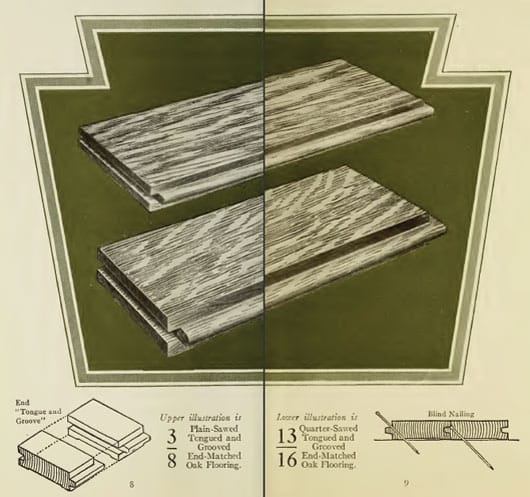
Another thing that has come a long way since the 20’s is sanding procedures and equipment. Back then pretty much everything was done by hand.
Can you imagine how much work it would be to smooth a 1,000sqft floor with a hand scraper?
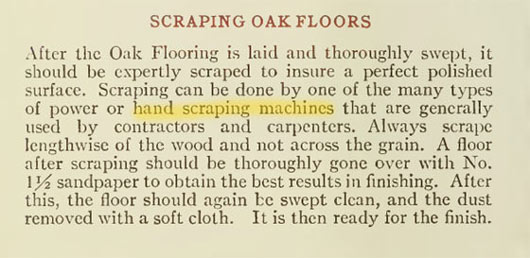
Even the power scrapers in the 1920’s weren’t easy to use and they weighed a ton. Check out this old ad (again in Chicago!) from 1915…

Can you imagine the weight of that contraption on the right?
It wouldn’t be for a few more years until more affordable and truly portable sanding machines would come onto the market. (Maybe in another blog post it would be fun to show the progression of hardwood floor sanding machines. I have quite a few old ads for these too).
Another thing that has definitely changed since the 20’s is the use of dangerous products on floors such as gasoline.
Have a look at the process they suggested for wood floor filler…
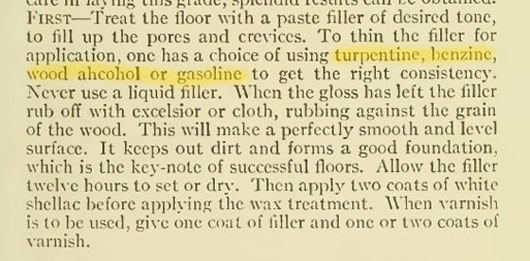
Probably the most obvious changes and advancements in the hardwood flooring industry since the 1920’s have been in protective finishes and coatings.
In the snippet above from 1920 you can see the recommendation of shellac, wax or varnish as the choice finishes to use on wood floors. And again in 1921, the booklet below titled “The Perfect Floor” has the same suggestions…
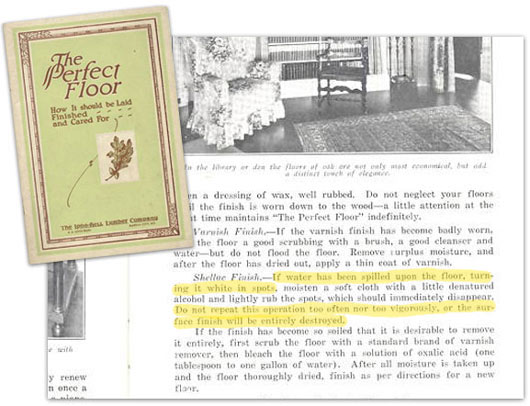
These finishes had severe limitations though.
In the highlighted section above it says this about Shellac Finish – “If water has been spilled upon the floor, turning it white in spots”… and then suggestions are given on how to clean the floor, but it continues with… “Do not repeat this operation too often nor too vigorously, or the surface finish will be entirely destroyed.”
That was the problem with wood floor finishes in those days… they were very finicky and needed to be constantly maintained and re-waxed.
As we saw in the previous article, this was a laborious task done with a heavy and awkward wax polishing brush.
But in the 20’s, electric versions of these brushes started to become popular. It’s fun to see the marketing they used for them. Here’s an ad from 1925 from the Ponsell Floor Machine Company…
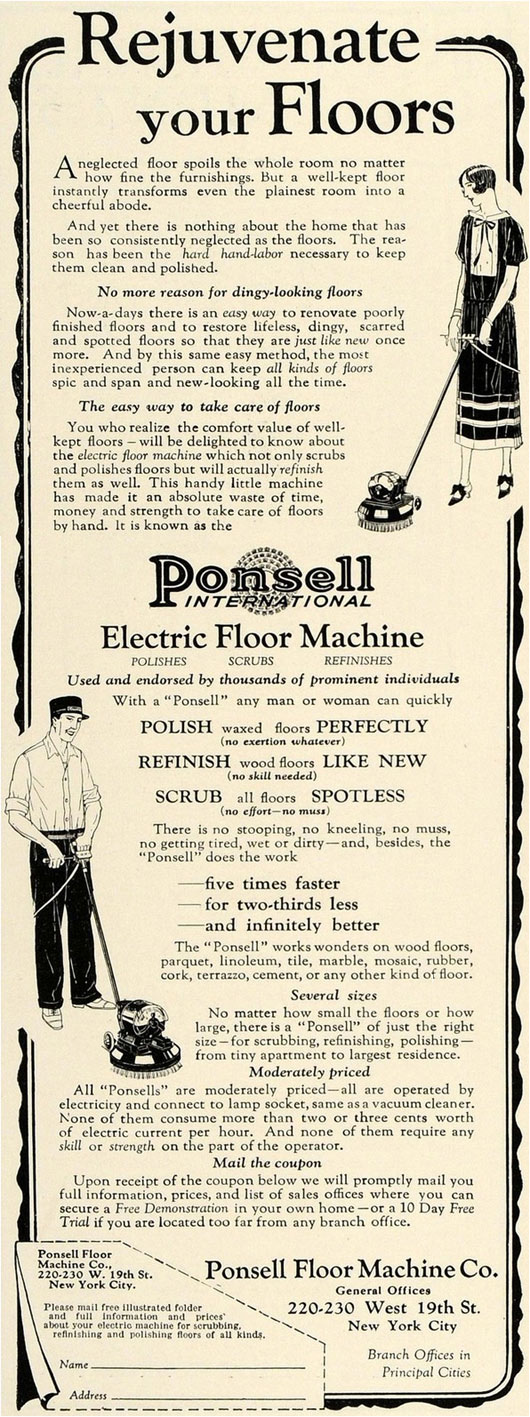
“No exertion whatever” – “No skill needed” – “No effort = No muss” – “Five times faster”… who could resist purchasing one of these for their floors?
Here are two more ads from 1926 for these ‘Electric Floor Polishers’…
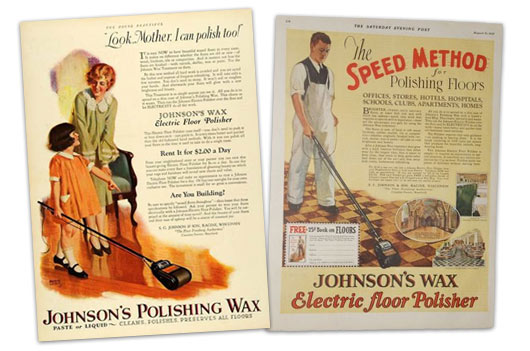
…so simple even a child could do it.
Compared to hand polishing I’m sure they were far easier. They still didn’t do anything to better the finishes used though, just make it easier to maintain them.
Here’s another 1920’s brochure from the same wood floor and furniture finishing supply company as the ads above…

I love the suggestion they have on Page 6 for waxing dance floors…
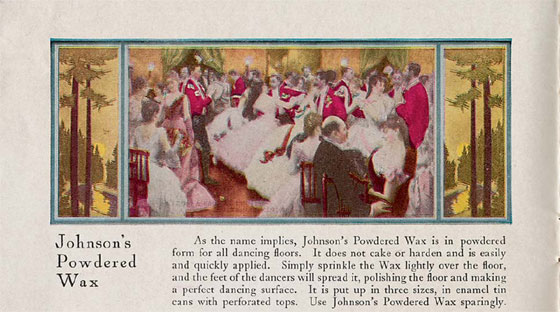
… “Simply sprinkle the Wax lightly over the floor, and the feet of the dancers will spread it, polishing the floor and making a perfect dancing surface.”
What a great idea.
From now on we should host hardwood floor finishing ‘Dance’ parties for our clients lol.
The Late 20’s and Beyond…
By the late 1920’s wood floors started to have major competition from linoleum floors, which offered far less maintenance and hassle. To combat this, varnishes were reformulated with resins to improve hardness, durability and cure time.
By the 1930’s polyurethane was becoming popular and the old wax and shellac floors were coming to the end of their long – and very useful – days.
Wood floors continued to be extremely popular through the 40’s, especially during the housing boom after World War II. Then in the 50’s, carpet and vinyl began to be more affordable as well as being much easier to maintain. And that’s when the bottom fell out of the wood floor market… which is a shame because that’s when some of the best machinery started to come out to make this job a whole lot easier.
Since then there’s been some amazing advancements in hardwood floor finishes.
Unlike in the 20’s and prior where high maintenance wax or shellac were your only options, we now have such a huge choice of high quality, low hassle finishes to choose from. And hardwood is again the top choice of flooring for homeowners.
In Conclusion…
That was fun to have a glimpse into the past.
If you happen to be lucky enough to have one of those original old hardwood floors from a previous generation, enjoy it and appreciate its history and all the wonderful character it holds.
These floors are priceless.
Think of all the effort and backbreaking work someone spent installing them without power tools, scraping them smooth by hand and then hand waxing them. You’re walking on history.
Also, as you think about previous generations, be very thankful that your weekend doesn’t have to be consumed with stripping your floors with turpentine, filling the gaps with a concoction of filler and gasoline and then re-applying wax over them.

And last but not least…
[Start Rant] If you have incredible floors from the 1800’s, the 20’s or even the 50’s – Please don’t hand them over to the cheapest ‘floor sander’ in town who will end up destroying them by grinding them into oblivion! These historic antique floors need to be preserved and treated with the utmost care, not just handed over to the lowest bidder who has no appreciation for them and is only thinking of getting them done as fast as possible so he can move onto his next job. [End Rant]
Oh and one more thing to wrap up this post… if you happen to have any historic floor machines, advertisements or pamphlets/brochures lying around that you don’t need… we’d be more than happy to provide a safe home for them.
Ps. I found a great write-up of the history of wood floors over the last 100 years. It goes into a lot more detail than this article. If you’d like to read it you can find it here.
–
Updated Jan 2023

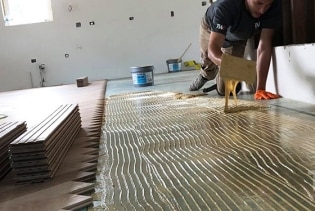
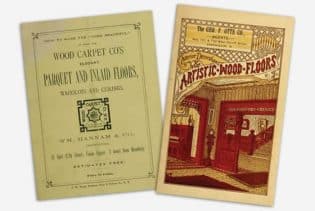
Hello Tadas, I just read through pretty much all of your blog posts. I just wanted to say that you have one of the most interesting websites about wood floor finishing around. Very interesting and informative, thank-you!
Thank you Nathan :)
Never ran into this before but I have a customer that wants her gmothers 60 yr old 2 1/4 parquet waxed. They really need to be refinished. I know they wont be maintained properly. But is there a Hardwax system you know of thats compatible with 60 yrs of buffed on paste wax?
Hi C Brown,
Sorry but I don’t know any product that is compatible with past wax. Sounds like they will need to be stripped and sanded which will not be a fun job.
Good luck.
Tadas
Hi Tadas,
I wanted to ask you about the floors that are in my brothers house.
The house is old. 1920. The floors I think is oak???
I want to removed 4 layers of tile and stripped and stain
the floors. ( Which I think would turn out very, very good )
My brother is not a happy person. He thinks I should just cover the floor up and leave things the way they were before
I got there.
I still think that the floors would look great if I sanded and stain, and put a high gloss finish to them.
I wanted to find out if I go this route would it be a lot of
work ahead of me.
Thanks
Helen Johnson
Hi Helen,
Wow, you’re very fortunate to have floors from the 1920’s. Yes… it will be a lot of work removing all those layers of flooring. It will also be a lot of work restoring the floors. But… I imagine they will look wonderful once done! It will also bring the floor level back to original.
Are you looking to do it all yourselves as DIYers or get professionals in?
If cost is a factor, maybe you could carefully do the removal and disposal of the 4 layers yourselves, saving a lot of money, and hiring a pro to restore them for you.
Please let us know what you decide. And good luck with your brother :)
Tadas
I own a Posell waxer/buffer that looks identical to the one in the advertisement. We rewired it and it works wonderfully on my parquet floors.
Visitors always comment on our beautiful floors.
That’s very cool :)
It may be worth something one day!
Tadas
well I live in a 1920 house in buffalo ny and the kitchen floor is on the downward slope going all the way down. the landlord is a slumlord who wont fix anything. the floor is rotting and the foundation has to be repaired which could cost in these homes about $150,000 or so give or take. I wish I had the money to fix. thank you for your article.
You’re welcome Janis
My flooring says Acorn Brand N.H.F CO. NO 2. Oak.
Is this you guys? What would the time period be? This is the 2nd layer of our 1890s house. I’m guessing 1920-50s? I see remnants of the early kitchen plumbing so its been there a while, I think….
We have that, too! Pittsburgh PA.
Hi Chris, just stumbled across this- I have an 1890s with flooring marked Acorn Brand too. Interested if you ever found info on yours…
Hi Chris,
No it’s not us sorry. We just install and refinish wood floors. We aren’t a flooring mill.
Tadas
So we’ve just bought a beautiful home from 1920 here in Chester SC 3400 Sf formal residence 95% original !!! and this home has all its original hardwood flooring. The butlers pantry and kitchen they had covered the floors with plywood that was nailed down putting hundreds of nail holes into the original wood floors, so now as we begin to restore them we’re torn between filling the holes or leaving, also weather to wax the floors or put a hard finish on them as to make mopping east. Any suggestions thanks Anthony
Hi Anthony,
Wow lucky you! It’s becoming rare to find old houses in original condition. As far as the nail holes, personally, I’d probably leave them as they are and see it as the history and character of the home. If you fill them, it can be hard to color match every hole with the color and shade of each board. They would most likely stand out and be more visible.
For finish, if these we my floors, I’d be using Pallmann Magic oil on them. You can read about this finish here:
https://napervillehardwood.com/blog/the-hardwax-oil-experiment-part-4-pallmann-magic-oil/
and here: https://napervillehardwood.com/blog/revisited-pallmann-magic-oil/
You will need to make sure all the previous wax is removed and the floors are super clean before applying a new finish. But once done, they will look stunning.
Good luck Anthony.
Tadas
I found your blog looking for ways to spruce up my old hardwood floors. I love them and I’m pretty sure they are original to my 1920s apartment, but twice “helpful hands” have wet mopped them. I caught it the first time but not the 2nd and now the boards are dull looking, even after cleaning with oil soap (damp mop followed by dry microfiber mop). I’m considering polishing them (I’m sure they are sealed with something, I had them glowing when I first moved in). It’ll be a while before I get a professional to come in.
Hi Nic,
Nice to have such old floors. Just be careful with the oil soap. It can lead to contamination issues down the road if you have them refinished.
Tadas
Hi Tadas, My Grandfather was a FLOOR Man from 1920 to 1962 in Columbus, Ohio. I have his Old Floor Polisher, (1940s), Edger, & Floor Sander from the Late 50s to 60s, is there any place that would take this Equipment & display it or put it to GOOD use. Thank You
Hi Garry,
Very cool. I don’t know of any place per se, but you could ask the guys over at NWFA.org if they do.
Or make a post here: https://www.woodfloorbusiness.com/forum
Or you could contact some local hardwood floor businesses and see if they would like them. I’m pretty sure someone would love to give them a new home.
Tadas
Hi! Im restoring our 1920’s house wood floors and the only room I have yet to uncover from plywood and peel and stick is the bathroom. The majority of the house is oak except the kitchen, I believe it is pine.
It looks like the oak runs from the hallway under the plywood & peel & stick in the bathroom but im hesitant to pull it up. Any idea if it was common to put wood floors in the bathroom then as well?
Thanks!
Hi Ally,
Not sure of your location and what was common in your area back then sorry. But yes, it was definitely done by some builders in many states. Oak was more expensive so it was only installed in the main living areas of some houses.
Would definitely be worth checking.
Tadas
This is fascinating! I have a home from 1923 that’s been neglected but the floors are still in okay condition. For lots of reasons (I have birds and can’t afford to move them out, and my boyfriend is chemically sensitive), I’ve decided not to sand (scrubbing and mopping) and to treat the floors with hemp oil and then no-voc wax. The hemp oil is just about dry and it’s really brought out the beauty of the oak. There’s definitely wear’n’tear from the house being a slumlord rental property, which I’ll have to deal with at some point… just wanted to preserve them from my birds and my own heavy usage.
Very cool to see how these floors were originally made and maintained!
Thanks!
Hi Jessica,
You’re welcome. Enjoy your antique floors :)
Tadas
Idk how old this is but I just wanted to say I’m happy I found this article. I recently purchased a home built in 1920 and when I lifted the carpet to see what’s underneath I found the whole middle section was wide planks. I thought someone cut this section out and I couldn’t find a reason why someone would cut a perfect square out of the floor. I thought about laying down a whole new floor but now I might consider keeping it the way it is since it’s original to the house.
Hi Melissa,
Yes it’s definitely original and well worth preserving if you can. Enjoy your unique floors :)
Tadas
I love reading about homes from the 1920s. Mine was built in 1921 in NJ. Are there definitely wood floors under all the tile and linoleum layers in my kitchen? If so, I can’t wait to pull it all up. In 1920 did all homes have wood floors throughout?
Hi Kelly,
I’m not an expert in NJ but the chance you have wood floors is pretty high (as long as a previous owner didn’t remove them). The type of wood is another matter. In many kitchens there was shiplap installed and that isn’t a finished floor like hardwood flooring is. Best bet is to take a look in a spot like under the stove or refrigerator first.
Tadas
What was a common wood used in floors in 1926 ? Or how do I tell? Mine are 2″ boards, is that a cheaper way than some of the wider planks I’ve seen? Just wondering if it is worth refinishing if there is no big mistakes in the flooring once I pull up carpet.
Hi Kathryn,
Oak, pine and fir were used a lot in most houses back then depending where you’re located in the country. Best bet would be to get a flooring professional to come by and check it for you to make sure.
Tadas
1925 straight grain fir flooring in entire 2nd floor of foursquare home. Was covered with tile since the 1960s. The tile was removed. There is some adhesive but not the tar-like variety. Planks approx 1 inch thick. Needs a sanding and refinishing. I know fir is softer than oak or maple. How do I interview a floor refinisher and ask appropriate questions to make sure they will be competent on the process and selection of products? Any type of product you feel is better than others? On the east coast NJ. Fir floors were just not nearly as common here as on the west coast or midwest. Eastern USA at that time many hardwood forests.
Hi Barbara,
Best way is to ask for photos of a job they’ve done that is similar. Fir is very soft as you’ve said. If it was bare for 40 years and then tiled for 60 years it will most likely have lots of character and shading marks that will be revealed as it’s sanded. If you don’t like character the best option is to stain it darker.
A far as finish, if I had 100 year old fir in my house I would use Pallmann Magic Oil. It has a nice build, can be stained first and can be recoated down the road without sanding down to bare wood.
For questions to interview a business with, have a look at this PDF here: https://napervillehardwood.com/5_Questions.pdf
Tadas
Hi Tadas. I just received 500 Sq ft of hardwood floor from a house built in 1920 (Boston area) paid $750. I am repurposing it in an 1876 rehab I am doing on my lake house. The floors are pristine. I’ve done one 250 sqft room (living room) and have enough for a second room! I love it. I did not refinish because I love the patina. I found a label on the underside of 1 board… SOFI Southern Oak Flooring Industries (trademark), stamped with CLR-P-R. and another stamp MM. I did see other boards stamped with K.C. FLOORING, or something like that. Have you ever run across SOFI FROM THE 1920s?
Hi Neil,
Sounds like you got a great deal. No I haven’t come across that brand sorry. Hope the project goes well.
Tadas
Hi Tadas, thanks so much for this great article. My husband and I are very interested in the evolution of things from the past to present, including architecture, and your article was a great read! We live in a house that was built in the 1920s in Chicago and think there are some really old floors in our mud room closets.
Aarti
Hi Aarti,
You’re welcome :)
Tadas
Love this article. I have 1925 home in Utah and when removing the carpet in the basement found hand painted thin wood covering the square in the center of the hard wood floors that you mentioned. It’s like a thin wood rug that can lift off the floor. Do you know where I can find more on the history of the center covering and how to get it appraised or who would be interested in preserving it?
Hi Melody,
Very cool. I don’t off the top of my head sorry. There may be a state heritage housing organization of some sort you could look up that may be interested perhaps.
Tadas
Hello Tadas,
My fiancé and I have a beautiful 1913 craftsman in east Los Angeles with what appear to be 2” red oak floors in some areas and 3” in others. We have a few boards with either termite or water damage and are looking to replace the damaged pieces with something as similar as possible to the original flooring planks. He did have them professionally refinished and we take extremely good care of them (fully nontoxic organic everything) what would you recommend?
Hi K&F,
Give Marcos at CMC Hardwood Floors a call. He’s the best floor guy in Los Angeles and he’ll be able to direct you to somewhere you should be able to get some reclaimed original flooring to repair those areas.
Tadas
Hi have a house in Newport, RI built between 1890-1900 -records burnt down. They are different woods but yellow pine about 2” tongue and groove on the second floor. I have sanded them with a triple head orbital, belt on edges. The floors are burnt orange in color, some of the stain, is not coming up even in an area that went a little deep, what is this and is it compatible with oil stain and poly? What would you use? One gentleman thought it was the oil from the wood? The sheen itself appears to be off, used 36, 60, 80, hand orbital 120 then some areas 150. Unfortunately some areas have circles still, but I don’t want to sand my floors away(hand to face with that last statement in the pamphlet). Some patched in yellow pine is much more yellow. Trying to match it together. Thank you.
Hi Sarah,
It’s tough doing a proper job with DIY sanding equipment like orbital sanders. You really need a professional belt sander like a Hummel to remove the finish and old stain properly and get down to bare wood. Best bet would be to get a reputable floor refinishing contractor out to take a look for you. He’ll be able to see your floors in person and know what you’re dealing with.
Tadas
My husband and I have recently purchased an extended cape cod house built in the late 70’s. It is on a hill overlooking a beautiful river and the house has some nautical features such as a porthole, window in the dining room. We want to restore some worn peg and plank wood floors in the front entry foyer and the upstairs landing and hallway, as well as the solid oak stairs leading to the second floor. The entry has seen the most wear and is very tired looking. The flooring is 3/4” thick and should have a lot of life left. Any tips on how to do this would be helpful.. Thank you!
Hi Jane,
Best bet would be to get a professional out to take a look for you. Give Jimmy from Dans Custom Hardwood Floors a call on (781) 380-0768. He works in your area and is an amazing floor contractor.
Tadas
Hello Tadas,
What brings me to your blog post is that I have one of these brochures you speak of- I found it at a thrift shop for a dollar in Portland Oregon when traveling. I am so sad to admit that I’ve lost the pages of it besides the cover (I framed the cover just because I liked the artwork). I’m wondering if you ever came across this particular brochure, because I’m trying to uncover the publication date. The title on the brochure is “Treatment and Care of Floors,” the maker is John Lucas and Co., Inc. The image is a pale yellow floor, blue wall, two men are seemingly moving a grand piano. (I would attach a photo if I could)
Hi Eva,
Thanks for sharing. No I haven’t seen that one. Looks like the business ran between 1848 to 1930. But I did find this interesting article about John Lucas and the great Philly Paint King scandel:
https://hiddencityphila.org/2017/12/secrets-romance-scandal-the-hush-hush-love-of-phillys-paint-king-and-his-irish-lass/
I have a 1927 bungalow and all the floors, including the bathroom, are oak and in pristine condition…with the exception of the bathroom. Probably in the 1950s, when they did the Mamie Eisenhower pink, they covered the bathroom floor with vinyl. But I could see impressions through that and suspected it was oak like the rest of the house. When I tore up the vinyl, I was right. I want to keep the wood uncovered and refinish it. The bathroom is teenie…very small, so I want to do it myself. Any suggestions on what to use to keep it protected from water splashes? Thanks